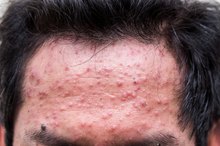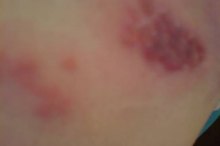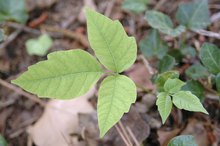What does fact checked mean?
At Healthfully, we strive to deliver objective content that is accurate and up-to-date. Our team periodically reviews articles in order to ensure content quality. The sources cited below consist of evidence from peer-reviewed journals, prominent medical organizations, academic associations, and government data.
The information contained on this site is for informational purposes only, and should not be used as a substitute for the advice of a professional health care provider. Please check with the appropriate physician regarding health questions and concerns. Although we strive to deliver accurate and up-to-date information, no guarantee to that effect is made.
Facial Skin Blisters
Facial skin blisters may be caused by a variety of different conditions and organisms. They can occur at any age in healthy people, but the majority of facial blisters happen to people that have chronic health problems, especially those that involve poorly functioning immune systems. They can be painful or not, filled with fluid, bacteria or blood, and tend to have a thin outer layer that bursts very easily. It's important to determine the cause of the blisters and learn from your healthcare provider how to treat them properly.
Identification
Blisters, or bullas, are easy to identify. They are a localized swelling of the skin that contains a watery fluid or serum, caused by chafing or irritation, an infection or burning. They typically have light to dark red skin around them. Most people experience blisters at one time or another, and may associate them with the feet, when shoes rub the skin and cause an irritation. Blisters on the skin of the face are typically caused by viral or bacterial infections and can be embarrassing.
- Blisters, or bullas, are easy to identify.
- Most people experience blisters at one time or another, and may associate them with the feet, when shoes rub the skin and cause an irritation.
Herpes Simplex
Common Skin Rashes on the Face
Learn More
According to Dermnetnz.org, herpes simplex, or HSV, is the most common viral infection causing facial blistering 2. Herpes simplex type 1 is the virus that causes "cold sores" or "fever blisters." Most people have carried this virus at one time or another, probably in early childhood 2. The first time the virus invades, it causes fever, malaise, red, swollen gums and lesions or blisters inside the mouth.cause:
- The first time the virus invades
- it causes fever
- malaise
- red
- swollen gums
- lesions or blisters inside the mouth
It then remains latent in the nerves that supply feeling in your skin. If your immunity is poor, then the virus can reoccur, traveling up the nerves and out to the skin, where multiple blisters can form. These blisters are most common on or near the lips but can occur anywhere on the face. They begin with itching and burning, and within hours, small, closely grouped blisters can appear. They heal within seven to 10 days without scarring. Acyclovir is the medicine of choice when treating them.
- According to Dermnetnz.org, herpes simplex, or HSV, is the most common viral infection causing facial blistering 2.
- The first time the virus invades, it causes fever, malaise, red, swollen gums and lesions or blisters inside the mouth.cause: * The first time the virus invades
* it causes fever
* malaise
* red
* swollen gums
* lesions or blisters inside the mouth It then remains latent in the nerves that supply feeling in your skin.
Herpes Zoster
Another fairly common cause for facial blisters is the herpes zoster or varicella zoster virus, the same virus that causes chickenpox. This virus also affects the nerves leading to the skin and can recur in adults as "shingles." This is a very painful, blistering rash that may include the face, eyes, mouth and ears. Medline Plus reports that shingles can occur at any age, but the risk is higher for people over 60, who had chickenpox before the age of 1, and who have a weakened immune system 3. Tingling and burning of the skin begins, followed by pain, sometimes severe, red patches and then blisters. The blisters break, forming small ulcers that dry and become crusty. The crust falls off in two to three weeks. Again, Acyclovir is the medicine of choice for treatment.
- Another fairly common cause for facial blisters is the herpes zoster or varicella zoster virus, the same virus that causes chickenpox.
- Medline Plus reports that shingles can occur at any age, but the risk is higher for people over 60, who had chickenpox before the age of 1, and who have a weakened immune system 3.
Impetigo
How to Prevent the Spread of Shingles
Learn More
Impetigo blisters are usually caused by the staphylococcus aureus bacteria. Children often get this, especially if they touch their faces often or are obsessive nose pickers. According to the American Academy of Dermatologists, the bacteria that causes impetigo is present in the nostrils of approximately 20 to 30 percent of the population. Once these blisters on the face form, they are easily ruptured and form shallow erosions with a yellowish brown crust. These blisters are treated with antibiotics.
- Impetigo blisters are usually caused by the staphylococcus aureus bacteria.
Warning
Other causes of blistering skin can be attributed to cellulitis, or inflammation of skin cells, allergic reactions, lupus and basal cell carcinoma, or skin cancer.cause:
- Other causes of blistering skin can be attributed to cellulitis
- or inflammation of skin cells
- allergic reactions
- lupus
- basal cell carcinoma
- or skin cancer
If you develop facial blisters and are unsure of the cause, it is important to see your doctor, who will visualize the blisters and take a thorough medical history 1. Your skin is a reliable, outward detector that tells you something is wrong internally and prudent patients will seek the advice and treatment of a dermatologist.
Related Articles
References
- The Medical Dictionary: Blisters
- Derm Net NZ: Herpes Simplex
- Medline Plus: Shingles
- Facts about chickenpox. Paediatr Child Health. 2005;10(7):413-4.
- Sampathkumar P, Drage LA, Martin DP. Herpes zoster (shingles) and postherpetic neuralgia. Mayo Clin Proc. 2009;84(3):274-80.
- Gladman AC. Toxicodendron dermatitis: poison ivy, oak, and sumac. Wilderness Environ Med. 2006;17(2):120-8.
- Groves MJ. Genital Herpes: A Review. Am Fam Physician. 2016;93(11):928-34.
- Opstelten W, Neven AK, Eekhof J. Treatment and prevention of herpes labialis. Can Fam Physician. 2008;54(12):1683-7.
- Abreu-Velez AM. Dyshidrotic eczema: relevance to the immune response in situ. N Am J Med Sci. 2009 Aug; 1(3): 117–120.
- Banerji A. Scabies. Paediatr Child Health. 2015;20(7):395-402.
- Pereira LB. Impetigo - review. An Bras Dermatol. 2014;89(2):293-9. doi:10.1590/abd1806-4841.20142283
- Ilkit M, Durdu M, Karakaş M. Cutaneous id reactions: a comprehensive review of clinical manifestations, epidemiology, etiology, and management. Crit Rev Microbiol. 2012;38(3):191-202.
Writer Bio
Jean Jenkins has been writing professionally since 1994. She has written medical research materials for the American Parkinson's Association, the Colorado Neurological Institute and the Autism Society of America. Jenkins has specialized in neurology, labor and delivery, high-risk obstetrics and autism spectrum disorders. She holds a Bachelor of Science in nursing from the University of Colorado.









